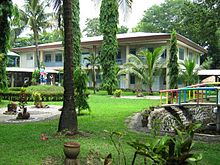- Somaschi Fathers
-
The Somascan Fathers are a charitable religious congregation of priests and brothers, founded in Italy in the 16th century by Saint Jerome Emiliani and named after the mother-house at Somasca. They are often called Somascans for short. Their formal name is Ordo Clericorum Regularium a Somascha, abbreviated as C.R.S. after members' names. There are currently about 500 Somascans serving around the world. They run many boys' homes, pastor parishes, and engage in other ministries.
History
In 1532, the priests Alessandro Besuzio and Agostino Bariso joined the charitable labors of St. Jerome Emiliani, a converted former soldier from Venice. St. Jerome founded the religious order called the "Company of the Servants of the Poor" in 1534, calling together his collaborators and companions for a general assembly. This handful of laymen and priests adopted an organized structure for the movement of religious and social reform started by Jerome in 1529 in Venice. Their goal was to dedicate themselves to the care, assistance, promotion of poor, orphans, abandoned youth, sick, etc, to any kind of works of mercy, and to any pastoral ministry according to the instructions of the bishops. placing the motherhouse at Somascha, a secluded hamlet between Milan and Bergamo. In the rule, Jerome puts down as the principal work of the community the care of orphans, poor, and sick, and demands that dwellings, food and clothing shall bear the mark of religious poverty.
After the death of Jerome, his community was about to disband, but was kept together by Gambarana, who had been chosen superior and obtained the approval (1540) of Pope Paul III. In 1547 the members vainly sought affiliation with the Jesuits; then in 1547-1555 they were united with the Theatines. Pius IV (1563) approved the institution. St. Pius V raised it to the dignity of a religious order, according to the Rule of St. Augustine, with solemn vows, the privileges of the mendicants, and exemption. In 1569 the first six members made their profession, and Gambarana was made first superior general. Great favour was shown to the order by St. Charles Borromeo, and he gave it the church of St. Mayeul at Pavia, from which church the order takes its official name "Clerici regulares S. Majoli Papiae congregationis Somaschae".
Later the education of youth was put into the programme of the order, and the colleges at Rome and Pavia became renowned. It spread into Austria and Switzerland, and before the great Revolution it had 119 houses in its four provinces: Rome, Lombardy, Venice, and France.
Following early 20th century statistics, obtained from F. Gius. Landini of the Somaschi at the Curia Generalitia at Rome, the order counted in three provinces (Rome, Lombardy, and Liguria) 16 houses, all in Italy except one (in Bellinzona, Switzerland), and about 180 members, of whom 100 are priests, 50 clerics, and 30 lay brothers. At Rome they had three houses: San Girolamo della Carità, residence of the general and one of the three novitiates (the other two being in Genoa and Somasca); Santa Maria in Aquiro with a parish and orphanage; Sant'Alessio on the Aventine for blind boys. The congregation managed three colleges with classical and technical studies at Spello, Como, Nervi, and finally, including those already mentioned, three orphanages and five parishes.
First the Company was recognized by the papal nuncio to the Republic of Venice in 1535 and then approved by Pope Paul III in 1540, and finally constituted as a religious order by Pius V in 1568 with the name of Somascan Regular Clerics. At this time the first Constitutions were issued to define a common lifestyle for all its members, both lay and clergy. In 1767, the Church canonized its founder, Jerome Emiliani. Moved by the zeal of its founder, the Order extended its charitable ministries beyond the care of orphans by supporting and staffing seminaries (just then mandated by the Council of Trent), by educating and forming youth, and by ministering to people in parishes. Its expansion, however, was abruptly stopped by laws obstructing religious life issued by Napoleon in 1810 and by the Italian government in 1861. It followed a painful dark period characterized by persecution, injustice, suffering, from which only at the beginning of the 20th century has the Order emerged with new vitality. It expansion resumed, reaching new continents and new countries. Nowadays, the Somascans number about 500 religious.
Today
The Somascan Fathers and Brothers continue St. Jerome's mission by: living in communities pursuing holiness by prayer and ministry to the poor living in humility and kindness loving poverty and work praying to the Crucified Jesus and Mary Mother of the Orphans being either priests or brothers. Performing different ministries in the Church, such as: care of orphans, disadvantaged and poor treatment of at-risk-youth rehabilitation of drug addicts education pastoral care and spiritual guidance pastoral care of minorities foreign missions youth formation. Working in: group homes treatment and rehabilitation centers retreat houses schools youth centers parishes. Somascan efforts are in the following countries: Europe: Italy, Spain, Poland, Romania, Americas: USA, Mexico, Guatemala, Honduras, El Salvador, Colombia, Ecuador, Brazil Asia: Philippines, India, Sri-Lanka, Australia.
Source
 This article incorporates text from a publication now in the public domain: Herbermann, Charles, ed (1913). "Somaschi". Catholic Encyclopedia. Robert Appleton Company.
This article incorporates text from a publication now in the public domain: Herbermann, Charles, ed (1913). "Somaschi". Catholic Encyclopedia. Robert Appleton Company.
Categories:- Clerks regular
- 1532 establishments
- Religious organizations established in the 1530s
- Roman Catholic religious orders established in the 16th century
Wikimedia Foundation. 2010.

